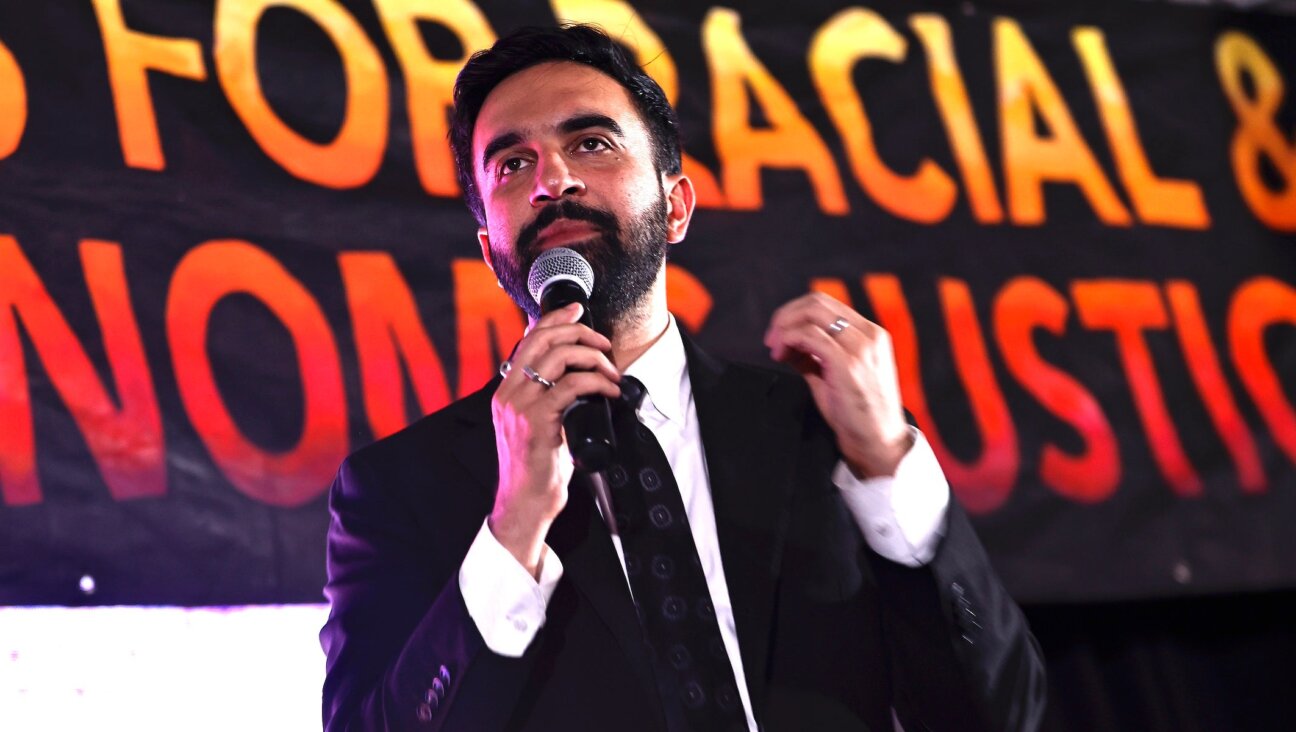How Netanyahu Beat Livni: The Branding Behind Israel’s New PM
They struggled against each other for months, trying to win more and more votes for their own candidates. They came up with complicated statistical formulas and paid close attention to focus groups while fashioning the perfect message that would lure undecided voters. Their recommendations served as a basis for various strategies that eventually led to the recent election’s complex outcome: Kadima with 28 mandates and Likud with just 27, but with a government headed by its chairman, Benjamin Netanyahu. Two months after the election, the political strategists who advised Netanyahu and Kadima leader Tzipi Livni met for a joint interview with Haaretz.
Israel Bachar, 38, has been working with Netanyahu for the past two years, since returning from the United States, where he worked in political campaigns and received a master’s degree in political communications at New York’s Fordham University.
Kalman Gayer, 61, is a former sailor, economist and sociologist, who has been working in Israel’s political arena for almost three decades; he was a close adviser to prime ministers Yitzhak Rabin and Ariel Sharon. He was a member of Livni’s strategic team, responsible for research. However, Gayer says he played only a minor role in devising her campaign messages, so as to maintain a separation between the professional research he conducts and the application of its results.
In contrast, Bachar, a member of Netanyahu’s small, intimate team even in the days when Likud seemed to be far from assuming power, did participate in creating his candidate’s campaign messages. In his work, he says he was also assisted by the Midgam marketing research company.
“I am first and foremost a sociologist, and research is a tool used to understand the electoral world’s sociological processes. Message-planning is a subcategory that requires expertise,” Bachar explains.
It is amazing to see how close the two men’s professional philosophies are; they almost complete each other’s sentences. The differences between them reflect the personal loyalty to their respective candidates and campaigns, rather than disagreements over Israeli society, voter preferences or essential aspects of political strategy. Their Hebrew is replete with English words and professional jargon.
Bachar: “At the beginning of the campaign, we had to define its main thrust: Leadership in a time of crisis. When the government fell [when prime minister Ehud Olmert announced his intention to resign, last July], we undertook two major studies and concluded that Netanyahu was perceived as a strong leader, a man of principles, while Tzipi Livni was a ‘feel-good candidate,’ who had no supporting attributes beside credibility.
“The resulting message was ‘Strong in security and strong in economics’ – traits that were attributed to Netanyahu as the leading political brand name. Our first inclination was to use the slogan, ‘Likud, because a state has to be managed.’ We reckoned that voters considered Netanyahu to be a very successful manager, whereas Kadima failed in running the state, but then the war [in Gaza] erupted, and that message was shelved.”
Gayer: “It was clear to us that we were going to focus on personal matters rather than on policy.”
Bachar nods vigorously as Gayer continues: “In our research, focusing on which characteristics lead people to prefer one candidate over another, we found that Tzipi had an advantage over Bibi: Her credibility was stronger. By far. As was her judgment. The two of them were ranked about the same in terms of other traits, such as problem solving and leadership. People want a prime minister who does not make decisions capriciously, without examining them first, who has a good perception of reality and who is capable of finding solutions to problems that may emerge. The fourth element is the ability to lead.”
Bachar: “Netanyahu is the strongest political brand name in Israel, and that’s why he could make a comeback. You cannot become prime minister twice, unless you are a brand name. Tzipi is a product-in-the-making, but not a brand name yet. A significant number of the mandates Likud won were the result of personal support for Netanyahu, which is why he was at the center of the campaign. Because of the realities here, the economic crisis and the security crisis were the favored topics.
“When we analyze the Netanyahu brand, we find very strong attributes of economic management and of a strong leader who can tend to security matters. On two topics [which were surveyed] there were 30-percent gaps between him and Tzipi: In the category of ‘being a strong leader,’ the ratio was 65:28 and in the economy, 60:30.”
So where is the problem?
Gayer: “The problem is personality. That’s why I focus on traits and he [Bachar] is busy with skills. Each side tried to highlight its candidate’s strong points. Bibi had a longer record and an image of being someone who succeeded with the economy like no other acting Israeli leader, from his two years as finance minister [2003-2005]. In the eyes of the right, he is also a strong leader and is considered security-minded.”
According to Gayer, Netanyahu’s problem stemmed from the bad memories he created during his first stint as prime minister, from 1996 to 1999. His return to power is an outcome of two “life-changing events”: His record as finance minister, which reestablished him as a leading national statesman, and the disengagement from Gaza, which Netanyahu originally supported, but from which he withdrew his support a week before the withdrawal began, when he resigned from the cabinet. “This was a slap in his own face because he was seen as a person who lacks credibility and flexibility.”
Bachar: “I don’t agree. What are you talking about?”
Gayer: “He was at rock bottom. It’s not for nothing that Likud received 12 seats [in the 2006 election]. But then it transpired that the disengagement did not produce peace and quiet, and the thesis that it would cause security problems proved to be right.”
Bachar: “This strengthened him as a leader, something that was reflected in all the studies: Netanyahu correctly predicted the future and therefore was suitable for leadership. That greatly distinguished him from Tzipi…. It had a dramatic impact on his brand name and on his ability to win back people.”
Gayer: “There is no doubt it brought back some Likud voters … The disengagement played an important role in defining Netanyahu as a leader with foresight, who takes risks. But in contrast, there is one trait about which most people agree, that he’s not trustworthy. You can’t believe a word he says.”
Bachar: “It’s not the entire public. How many percentage points did you get?”
Gayer: “That you can’t believe him? Sixty-four.”
Bachar: “That’s after the campaign. When the campaign began, it was 30.”
Gayer: “I’ll give you the data and we’ll compare.”
Bachar: “After [Kadima] ran a negative campaign with a huge amount of money, it rose.”
Gayer: “The campaign only enhanced an existing attitude.”
‘Trap of the tribe’
“We have a fundamental disagreement,” Gayer continues. “A person can say a certain issue really interests and is important to me, and Netanyahu can handle it, but I don’t believe what he’s telling me now … You must distinguish between his assumed capability to manage, lead, predict what lies ahead – and whether I accept what he tells me. That is Netanyahu’s big weakness.”
Bachar responds: “You are falling into the trap of the tribe. When the campaign began, two-thirds of the people did not consider Netanyahu’s credibility an issue. Moreover, people respected him because when he was finance minister, he purposefully took decisions that hurt him at the polls. That enhanced his credibility significantly, and rightly so. We focused on two-thirds of the public, the right-wing bloc. When Netanyahu talked, they believed him. If the right wing were not split, Likud would have skyrocketed.”
The research data dictated the marketing messages. Livni’s campaigners sought to expose her to as many listeners as possible; she spoke a lot and gave interviews. Netanyahu’s campaign emphasized his ideas and plans, but limited interviews. To counter the lack of credibility emphasized in the Kadima slogan, “Bibi, I don’t believe him,” Likud tried to leverage Livni’s lack of experience, devising the slogan, “It’s too much for her [to handle].”
Livni, Bachar says, launched a “feel-good candidate” campaign. She broadcast a good, credible feeling, but no more than that. Her campaign did not attribute to her managerial or decision-making skills, nor leadership experience. Her record was, well, that there was no record.
Bachar: “When we ran a study of our rivals, we discovered no action and no decision making. You say the public is aware of the need to have a strong leader who can take tough decisions in order to run the state, but the surveys did not show Tzipi as having such attributes. If she has never taken such decisions up until now, then leading Israel through a crisis is too much for her, hence the slogan we used. I’m telling you that even though you tried to present it as being sexist or hurtful to women – it was not perceived that way; the public and the political commentators did not view it that way. They considered the slogan to be fair, not below the belt.
“Initially, I was deeply concerned about this because we knew that two-thirds of the undecided voters were women, and this could have proved a boomerang. But the moment we understood that the public considered [the slogan] to be a legitimate, we went with it. What stopped everything was the war.
“Kadima had no message until 10 days before the election. It kept changing its messages – ‘Courage to change,’ ‘Courage to tell the truth,’ ‘What’s good for the state’ – something like that, and the feeling was that it had no real proposal to put on the table. This was a big difference between us. Netanyahu presented content: He really loves making policy and making plans. When he was in the opposition, he prepared a plan for education. When the campaign began, he presented a policy on taxes, a program for young people and a commitment to an safety net.”
Gayer: “That’s not important, because people do not believe him. It doesn’t matter what he says. They don’t trust him.”
Bachar: “I don’t agree. People trusted him – when it came to economic and security issues, because of his economic record – to pull this country out of the crisis.”
Gayer: “They believe he is capable of doing that, they don’t believe what he says.”
Bachar: “We tested capability, too, and found a willingness to listen to his messages on economic and security issues. That’s why our agenda focused on them. Tzipi had no proposals, she did not say what she was going to do. She had no plan, and that hurt her.”
Although marketing political parties and candidates is not the same as marketing soap or toothpaste, the methods are similar: Divide up the market, aim for a target audience and formulate positions that suit it. Both Gayer and Bachar agree that the Israeli-Jewish population is 50 percent secular, 30 percent traditional, 10 to 11 percent national-religious and 5 percent ultra-Orthodox. According to Bachar, “tribal identification” and the security issue had the greatest influence on voters. The peace process did not play a role this time, unlike in the 1996 elections, which focused on the Oslo accords.
Primary battleground
The primary battleground of the Likud and Kadima during the campaign involved 8 percent of the voters, who determined the outcome vis-a-vis 10 Knesset seats. In most cases, these were people who voted Likud in 2003 when it was headed by prime minister Sharon, then followed him to Kadima in 2006, and were now wavering between Netanyahu and Livni.
The two parties had other target audiences as well. The Likud sought to win two Knesset seats from national-religious voters and to attract young people. Kadima eyed the left wing, whom it considered captive audience.
“We won the left over effortlessly,” Gayer comments. “Even before the campaign started, Kadima had gained 2.5 seats from people who voted Labor in 2006, because of Tzipi. That’s why we defined our target audience as voters situated between Kadima and Likud. People who are right of center. The left was not our target audience. It came in droves, anyway.”
Political strategists often rank candidates on a scale that runs from right to left; Gayer’s scale runs from 1 to 5, while Bachar’s goes from 1 to 7. Despite this difference, the two generally agree: On Gayer’s scale, the public is today at 2.6 – in other words, a bit right of center – Livni is a little to the left, at 2.9, and Netanyahu is located at 1.8 or 1.9.
“In the voters’ eyes,” says Bachar, “Tzipi was in the center and Netanyahu appeared to be between the right wing and the moderate right, a ‘security-first’ person. Kadima was seen as the party of peace, Likud as the party of security and Labor had the image of being concerned with welfare; it lost the peace image to Kadima. That explains why at the end of the campaign, Livni’s terminology was distinctly leftist, and that drew voters from Labor and Meretz to Kadima.”
An election campaign is not influenced by “target audiences” and “messages” only, of course, but also by political reality. This led the country’s two biggest parties to adopt different strategies. The Likud, with 12 seats in the outgoing Knesset, had to increase its power base significantly to reenter the leadership race. At the same time, it had to keep the right wing at hand, says Bachar, and not “cannibalize” their voters and thereby harm potential coalition partners. This realization led Netanyahu’s campaigners to their most important decision: not to attack Avigdor (“Yvet”) Lieberman, Yisrael Beiteinu head and now foreign minister.
“That’s where the drama was,” Bachar explains. “We emerged from the operation in Gaza, and Yvet’s mandates increased. He climbed to 19 and we had to decide what to do. Some of us advocated a campaign aimed directly against him, a more negative campaign, to regain those mandates. Netanyahu wisely determined there should be no negative campaign within the right-wing bloc, to prevent cannibalization.”
What did you do?
Bachar: “Our surveys showed that people still believed they had two ballot slips to cast [one for prime minister and one for their preferred party, a system abandoned several years ago]. The minute people realized the system changed, the scales began tipping back.”
Bachar believes that the decision not to fight Lieberman paved the way for the latter to recommend to President Shimon Peres that Netanyahu, not Livni, form the coalition. That recommendation gave the Likud the edge it needed to assume power: “A war within the right would have led to losing the ticket – losing the insurance policy called ‘the bloc’ … For two years I’ve been arguing that Likud will not win more than 28 Knesset seats, because the bloc is split and that makes it difficult to win more than 30.”
Kadima had to cope with a different problem, media polls indicating that Likud was leading. This contradicted Kadima’s independent surveys and discouraged some supporters, who decided they would vote for a party that seemed likely to win.
Gayer: “A week before the election I saw that distorted polls were influencing voters’ decisions, even though my figures showed a tie or even an edge for Kadima, which turned out to be the real outcome.”
Kadima did not hesitate then to try to lure voters from the left-wing bloc. According to Bachar, the Likud’s analysis showed that Kadima’s success depended on Labor’s campaign. If Labor were to drop to less than 15 Knesset seats, Kadima would become significantly stronger; if Labor could pass that threshold, Kadima would not be perceived as a ruling party.
“Labor’s failure to wage a campaign that suited its public made it possible for Kadima to cannibalize it,” Bachar notes.
Labor’s ‘egomania’
The two political advisers agree that at best, Labor could have won up to 17 or 18 mandates, but no more. In fact, it got 13.
What was the problem with Labor’s campaign?
Gayer: “Egomania, period. The actions and shortcomings [of Labor chair and defense minister] Ehud Barak brought it up or dragged it down. One of the reasons for Labor’s sharp decline was the feeling that Barak was not the man people had expected him to be – one who would replace Amir Peretz [defense minister during the Second Lebanon War] and restore security. Suddenly, for some obscure reason, Barak was not striving to stop the Qassam attacks. People expected him to know how to tackle this problem, but he pushed for the tahadiyeh [cease-fire with Hamas], which turned out to be useless for Israel. When Hamas began firing not one or two sporadic rockets, but dozens a day, the feeling was that Barak was doing nothing.”
The two interviewees agreed that Operation Cast Led in Gaza was, without doubt, the definitive event during the election campaign.
Gayer: “The moment the decision was made – and in the first days there was an impression that we could handle the situation – the expected thing happened: Barak’s [popularity] increased, and Labor climbed from 12 mandates to 14-17 – mainly at Kadima’s expense, but also at the expense of Meretz. Kadima’s situation improved at Likud’s expense, because suddenly the entire bloc seemed potent. But when the operation was halted, in a move that people did not understand and considered cynical, some viewed Barak’s actions as electioneering …
“In our focus group, his moves were deemed cynical. [There was a feeling] that he thought he had made his electoral gains and was afraid they would be eroded. This was the harshest interpretation; I heard it with my own ears. That is why mandates shifted back from Kadima to Likud, and from Labor to Kadima. The gap between the blocs returned – from 61:59 or 62:58, in favor of the right wing, to 64:55, depending on the Arabs, of course. Gaza’s impact on Arab voters was very strong.”
Bachar and Gayer believe the operation in Gaza had the greatest effect on voters in southern Israel, as some 700,000 people in Ashdod, Ashkelon and Be’er Sheva were personally affected by the rocket fire. Many voters there were immigrants who, after the operation was stopped, voted in droves for Likud or Lieberman. Bachar says Livni tried to “don a security mask” during Cast Lead (Gayer: “It wasn’t a mask. She was genuine. She opposed the cease-fire”). But the message did not get through. However, Bachar notes, Netanyahu’s conduct was “statesmanlike and he gave his full support” to the military campaign.
When the operation ended, Lieberman gained considerable support, Likud maintained its edge and Kadima began losing ground.
Bachar: “I think that when we were emerging from Gaza, Kadima was on the verge of cracking, but it was Barak, not us, who had to take advantage of that. I felt that Tzipi was struggling hard to get people to recognize her role in the fighting. She was very verbal, tried to be very security-oriented, but was hurt to a certain extent after the operation. Then Yvet gained strength, Likud kept its power and Kadima had to decide what to do … Then came the last stage of the campaign, in which you [Kadima] veered further to the left with your message of peace. The security message benefited Likud and the peace message helped Kadima.”
Kadima chalked up a significant achievement in central, secular Israel while Likud did so in outlying areas. Bachar explains that Netanyahu managed to regain the support of “security-minded” voters, who had followed Sharon out of the Likud, and also identified an interesting group of women who voted Likud.
“I called them the ‘security moms,’” he says. “Women who tended to consider the security issue as being the most important tended toward the Likud, while those for whom hope for peace was most important clearly preferred Tzipi. In the run-up to the election, two-thirds of undecided voters were middle-aged women. Tzipi waged a women’s campaign, and we reacted with advertisements stressing that she had voted against [legislation favoring] women. The second factor was the security element, in which whose who sought security found it in Likud.”
The end of the fighting in Gaza had a powerful impact on voters’ preferences, which even surprised the experts.
Gayer: “It was impossible to predict that the end of the operation would have such a massive effect, just one week after people applauded it. Labor was wiped out.”
Bachar: “I was concerned about the electoral impact and Kadima should have been even more concerned had the operation lasted two more weeks. In no way would Kadima have then won 28 Knesset seats.”
Gayer: “No, no.”
Bachar: “Kadima would have faced a very difficult situation had the operation continued, because Tzipi wouldn’t have had time to shift attention to the topics she preferred: women and peace. That’s because Netanyahu was strong throughout the fighting.”
Gayer: “[During the operation] the two blocs were almost tied and that could have led to a different government.”
Bachar: “The right wing was leading halfway through, and it was clear to us that we were going to win. That’s why we preserved the right wing, strategically, as an insurance policy [to ensure] we would form the government.”
Both advisers stress that the decisions to go to war and then to stop the operation were not made for electoral reasons.
Gayer: “I distinguish between ‘statesmanlike decisions’ and their political impact. We are talking about the outcome, not about the motives. There may have been good, national reasons for ending the operation.”
Bachar: “We are engaged in an electoral analysis and are not judging anyone.”
Gayer: “As professionals, you know such a decision might carry a heavy price.”
So, who really won the election?
Bachar: “As Barak defined it, the outcome is the determining factor – who becomes prime minister. That’s what the fight was about.”
Gayer: “Netanyahu formed the government because his bloc stuck with him. However, if the election system were different – if, for example, there would have been a ‘law of the biggest party’ [meaning that the leader of the party garnering the most votes would form the coalition] – then the prime minister would have been from Kadima.”
Bachar: “If the system were different, our campaign would have been different. We worked according to existing parameters. You led by 0.8 percent, but that is irrelevant because the campaign was tailored to the rules of the game. We could have been more aggressive toward Yvet, but all along we maintained two parameters: our gap vis-a-vis Kadima, which would give us the legitimacy to form a government, and holding on to the right-wing bloc so that we could actually form it.”














